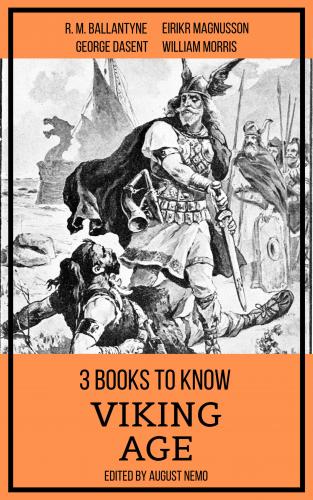3 books to know Viking Age. William Morris
Читать онлайн книгу.pty-line/>
Table of Contents
|
|
|
Introduction
WELCOME TO THE 3 Books To Know series, our idea is to help readers learn about fascinating topics through three essential and relevant books.
These carefully selected works can be fiction, non-fiction, historical documents or even biographies.
We will always select for you three great works to instigate your mind, this time the topic is: Viking Age.
The Norsemen in the West by R. M. Ballantyne
The story of Burnt Njal by Sir George Dasent
Volsunga Saga by Eirikr Magnusson And William Morris
The Viking Age (793–1066 AD) is a period in European history, especially Northern European and Scandinavian history, following the Germanic Iron Age. It is the period of history when Scandinavian Norsemen explored Europe by its seas and rivers for trade, raids, colonization, and conquest. In this period, the Norsemen settled in Norse Greenland, Newfoundland, and present-day Faroe Islands, Iceland, Norway, Sweden, Normandy, Estonia, Scotland, England, Wales, Ireland, Isle of Man, the Netherlands, Germany, Ukraine, Russia, Turkey and Italy.
Viking travellers and colonists were seen at many points in history as brutal raiders. Many historical documents suggest that their invasion of other countries was retaliation in response to the encroachment upon tribal lands by Christian missionaries, and perhaps by the Saxon Wars prosecuted by Charlemagne and his kin to the south,or were motivated by overpopulation, trade inequities, and the lack of viable farmland in their homeland.
The Norsemen in the West is a tale of adventure and evangelism, Ballantyne transforms into engaging historical fiction the well-known facts of the Icelandic Saga—stories of exploration and adventure, blessed marriage, alternating turmoil and peace with indigenous people—all sprinkled with delightful and humorous stories of day-to-day life surrounding the first European ground breaking in America.
The Story of Burnt Njal is a thirteenth-century Icelandic saga that describes events between 960 and 1020. The principal characters are the friends Njáll Þorgeirsson, a lawyer and a sage, and Gunnar Hámundarson, a formidable warrior. Gunnar's wife instigates a feud that leads to the death of many characters over several decades including the killing by fire of the eponymous "Burnt Njáll". The saga deals with this process of blood feuds in the Icelandic Commonwealth, showing how the requirements of honor could lead to minor slights spiralling into destructive and prolonged bloodshed.
Volsunga saga, most important of the Icelandic sagas called fornaldarsǫgur (“sagas of antiquity”). Dating from roughly 1270, it is the first of the fornaldarsǫgur to have been written down. It contains the Northern version of the story told in the Nibelungenlied. The saga was based on the heroic poems in the Poetic Edda and is especially valuable because it preserves in prose form some of the poems from the Edda that were lost. It became one of the sources of Richard Wagner’s operatic Ring tetralogy.
This is one of many books in the series 3 Books To Know. If you liked this book, look for the other titles in the series, we are sure you will like some of the topic.
|
|
|
Author
ROBERT BALLANTYNE (24 April 1825 – 8 February 1894) was a Scottish author of juvenile fiction who wrote more than 100 books. He was also an accomplished artist, and exhibited some of his water-colours at the Royal Scottish Academy. One of the young men influenced by Ballantyne was Robert Louis Stevenson (1850–94). He was so impressed with the story of The Coral Island (1857) that he based portions of his famous book Treasure Island (1881) on themes found in Ballantyne.
Sir George Webbe Dasent, D. C. L. (1817–1896) was a British translator of folk tales and contributor to The Times.
Eiríkr or Eiríkur Magnússon (1 February 1833 – 24 January 1913) was an Icelandic scholar at the University of Cambridge, who taught Old Norse to William Morris, translated numerous Icelandic sagas into English in collaboration with him, and played an important role in the movement to study the history and literature of the Norsemen in Victorian England.
William Morris (24 March 1834 – 3 October 1896) was a British textile designer, poet, novelist, translator, and socialist activist associated with the British Arts and Crafts Movement. He was a major contributor to the revival of traditional British textile arts and methods of production. His literary contributions helped to establish the modern fantasy genre, while he played a significant role propagating the early socialist movement in Britain.
|
|
|
The Norsemen in the West
BY R.M. BALLANTYNE
––––––––
Chapter One.
––––––––
